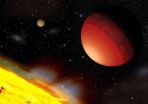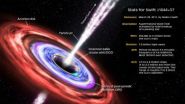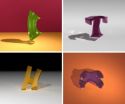(Press-News.org) KINGSTON, R.I. – August 2, 2012 – A postdoctoral researcher at the University of Rhode Island has observed a never-before-seen defensive strategy used by a small species of deep-sea squid in which the animal counter-attacks a predator and then leaves the tips of its arms attached to the predator as a distraction.
Stephanie Bush said that when the foot-long octopus squid (Octopoteuthis deletron) found deep in the northeast Pacific Ocean "jettisons its arms" in self-defense, the bioluminescent tips continue to twitch and glow, creating a diversion that enables the squid to escape from predators.
"If a predator is trying to attack them, they may dig the hooks on their arms into the predator's skin. Then the squid jets away and leaves its arm tips stuck to the predator," explained Bush. "The wriggling, bioluminescing arms might give the predator pause enough to allow the squid to get away."
The discovery was published in the July issue of the journal Marine Ecology Progress Series.
While Bush was a graduate researcher working with the Midwater Ecology Lab at the Monterey Bay Aquarium Research Institute, she observed that many octopus squid had arms of different lengths. Scientists had speculated that they may release their arms, just as lizards can release their tails when attacked, but no one had seen it happen. Using a remotely operated vehicle in the Monterey Bay Submarine Canyon off the coast of California, Bush poked at a squid with a bottlebrush.
"The very first time we tried it, the squid spread its arms wide and it was lighting up like fireworks," she said. "It then came forward and grabbed the bottlebrush and jetted backwards, leaving two arms on the bottlebrush. We think the hooks on its arms latched onto the bristles of the brush, and that was enough for the arms to just pop off."
The squid are able to re-grow their missing arms.
"There is definitely an energy cost associated with this behavior, but the cost is less than being dead," Bush said.
In further experiments, Bush found that some octopus squid appeared hesitant to sacrifice their limbs, but some did so after being prodded several times. When she provoked seven other squid species similarly, none dropped their arm tips.
Bush's research on squid began in 2003 when she decided to investigate the assumptions that some scientists had made about deep-sea animals.
"Scientists had assumed that squid living in the deep-sea would not release ink as a defensive measure, but all the species I've observed did release ink," she said. "They assumed that because they're in the dark all day every day that they're not doing the same things that shallow water squids are doing. They also assumed that deep-sea squid don't change color because of the dark, but they do."
The URI scientist's current research focuses on a tiny squid that lives in the Gulf of California that migrates every day from the dark depths where there is little oxygen to the surface waters to feed. She is examining their oxygen consumption rates and how increasing water temperatures will affect their survival.
"They're a really abundant species in the Gulf, so presumably if they are that abundant, they must be feeding on lots of different things and there must be lots of things feeding on them," Bush said. "They could be very important to the health of the ecosystem."
INFORMATION: END
In science fiction novels, evil overlords and hostile aliens often threaten to vaporize the Earth. At the beginning of The Hitchhikers Guide to the Galaxy, the officiously bureaucratic aliens called Vogons, authors of the third-worst poetry in the universe, actually follow through on the threat, destroying the Earth to make way for a hyperspatial express route.
"We scientists are not content just to talk about vaporizing the Earth," says Bruce Fegley, professor of earth and planetary sciences at Washington University in St. Louis, tongue firmly in cheek. "We want to understand ...
Last year, astronomers discovered a quiescent black hole in a distant galaxy that erupted after shredding and consuming a passing star. Now researchers have identified a distinctive X-ray signal observed in the days following the outburst that comes from matter on the verge of falling into the black hole.
This tell-tale signal, called a quasi-periodic oscillation or QPO, is a characteristic feature of the accretion disks that often surround the most compact objects in the universe -- white dwarf stars, neutron stars and black holes. QPOs have been seen in many stellar-mass ...
Durham, NC – What makes some species more prone to extinction? A new study of nearly 300 species of New Zealand birds — from pre-human times to the present — reveals that the keys to survival today differ from those of the past.
The results are important in light of the growing number of studies that try to predict which species could be lost in the future based on what kinds of species are considered most threatened today, said lead author Lindell Bromham of Australian National University.
In the roughly 700 years since humans arrived in the remote islands that make ...
Jeanne Romero-Severson, associate professor of biological sciences at the University of Notre Dame, and her collaborators, are tracking the evolution of the live oaks of eastern North America, seeking to understand how the trees adapted to climate change during glacial periods.
When the ice advanced, the oaks retreated. When the ice retreated the oaks advanced, spreading from tropical to temperate zones, up from Central America and Mexico into the Piedmont Carolinas. The researchers expect the study of live oak migrations and phylogeny will provide clues to the success ...
Computer-generated characters have become so lifelike in appearance and movement that the line separating reality is almost imperceptible at times. "The Matrix" sequels messed with audiences' perceptions of reality (in more ways than one) with action scenes mixing CG characters and real actors. Almost a decade later, superheroes and alien warriors dominate the multiplex. But while bipeds and quadrupeds have reigned supreme in CG animation, attempts to create and control their skeleton-free cousins using similar techniques has proved time-consuming and laborious.
Georgia ...
On the classic TV show "I Love Lucy," Ricky Ricardo was known for switching into rapid-fire Spanish whenever he was upset, despite the fact Lucy had no idea what her Cuban husband was saying. These scenes were comedy gold, but they also provided a relatable portrayal of the linguistic phenomenon of code-switching.
This kind of code-switching, or switching back and forth between different languages, happens all the time in multilingual environments, and often in emotional situations. In a new article in the July issue of Perspectives on Psychological Science, a journal ...
CHAPEL HILL, N.C. -- Treating chronic venous leg ulcers with a topical spray containing a unique living human cell formula provides a 52 percent greater likelihood of wound closure than treatment with compression bandages only.
That's the conclusion of a new study conducted in part at the University of North Carolina School of Medicine and published online by The Lancet this week.
The Phase II clinical trial, which investigates the efficacy of HP802-247 from Healthpoint® Biotherapeutics, was designed to determine effectiveness of certain cell concentrations and dosing ...
Our planet's changing climate is devastating communities in Africa through droughts, floods and myriad other disasters.
Using detailed regional climate models and geographic information systems, researchers with the Climate Change and African Political Stability (CCAPS) program developed an online mapping tool that analyzes how climate and other forces interact to threaten the security of African communities.
The program was piloted by the Robert S. Strauss Center for International Security and Law at The University of Texas at Austin in 2009 after receiving a $7.6 ...
VIDEO:
Gary Crameri, part of CSIRO’s bat virus team, discusses Cedar virus.
Click here for more information.
Australian scientists have discovered a new virus in bats that could help shed light on how Hendra and Nipah viruses cause disease and death in animals and humans.
The new virus - named 'Cedar' after the Queensland location where it was discovered - is a close relative of the deadly Hendra and Nipah viruses.
However, CSIRO's initial studies have discovered ...
http://www.AutismSeminarsOnDemand.com, a website created by Dr. Kurt Woeller featuring a compilation of his lecture presentations on biomedical autism intervention, announced today that it's offering drastically reduced pricing for the month of August.
Dr. Woeller's ability to provide detailed information regarding diagnostic testing, therapies, and protocols that is understandable for all parties makes his information unique in the world of autism education.
Each seminar available via the website is a presentation Dr. Woeller has previously given on a specific topic ...




